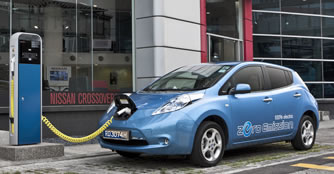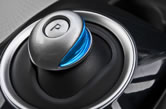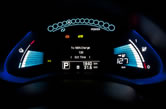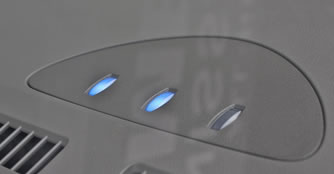Nissan Leaf (A) Review
06 Jun 2012|17,493 views
Mobility for the masses has long been thought as the key motivation behind the massive churning of automobiles, less the handful that are mind-blogged about handcrafting the exquisiteness of metal boxes on fours. With the Leaf, however, Nissan has seemingly brought personal transport for the masses to another level - with clean, emission-free energy.
Perhaps still a tad sceptical about the local consumer market, the Leaf is only available to corporate users under Tides (Transport Technology Innovation and Development Scheme), a local test-bed for electric cars which grants them tax exemption.
Nevertheless, the electric offering offers a glimpse of what is to come, arguably, for the future of motoring.
Exterior
The Leaf takes on the conventional five-door hatch package, albeit with subtle but carefully-thought out (claimed by Nissan) twitchings, all in the name of saving Gaia. For instance, the pointed headlamps and wing mirrors are works of aerodynamic-research.
The Leaf also receives LED headlamps (note, not the usual HID) for improved energy conservation, together with a stream of LED brake-lamps which adds onto the futuristic aura.
Perhaps still a tad sceptical about the local consumer market, the Leaf is only available to corporate users under Tides (Transport Technology Innovation and Development Scheme), a local test-bed for electric cars which grants them tax exemption.
Nevertheless, the electric offering offers a glimpse of what is to come, arguably, for the future of motoring.
Exterior
The Leaf takes on the conventional five-door hatch package, albeit with subtle but carefully-thought out (claimed by Nissan) twitchings, all in the name of saving Gaia. For instance, the pointed headlamps and wing mirrors are works of aerodynamic-research.
The Leaf also receives LED headlamps (note, not the usual HID) for improved energy conservation, together with a stream of LED brake-lamps which adds onto the futuristic aura.
 |
As a whole, the Leaf might not appeal to the most discerning motorists - loyal followers of Italian designs etc. Fans of sci-fi may however be adeptly captivated, especially if they take a closer look on the inside - think e-tron.
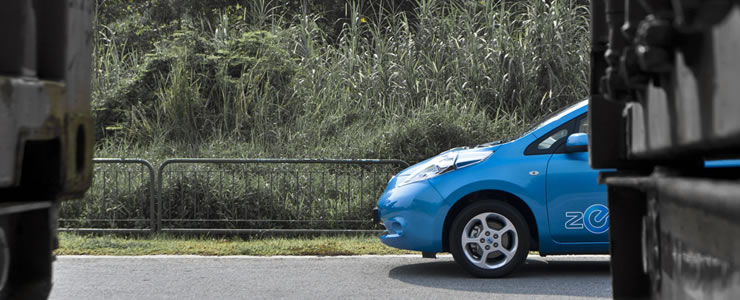 |
Interior
On the inside, the Leaf is easily the most futuristic of the quad EVs in Singapore. Nissan has also brought cinematics to the Leaf, playing a jingle with a wave-form of colours on the instrument panels during start-up.
Purpose-built meant that there were no compromise in the cabin and boot space, all thanks to clever engineering which 'hides' the battery pack in the floor of the chassis.
Taking centre stage is a seven-inch touch-screen monitor, which packs a number of built-in features, such as entertainment, vehicle information, and doubles as a display for the reverse camera when activated.
On the inside, the Leaf is easily the most futuristic of the quad EVs in Singapore. Nissan has also brought cinematics to the Leaf, playing a jingle with a wave-form of colours on the instrument panels during start-up.
Purpose-built meant that there were no compromise in the cabin and boot space, all thanks to clever engineering which 'hides' the battery pack in the floor of the chassis.
Taking centre stage is a seven-inch touch-screen monitor, which packs a number of built-in features, such as entertainment, vehicle information, and doubles as a display for the reverse camera when activated.
Interestingly, one will find the indicator stalks on the left and wiper controls on the right, just like what you get in continental offerings. This however, gives you a hint that the car was developed with the Western Continents in mind. For instance, the navigation system packs useful information such as charging-point locations. You can also check the status of the vehicle, or even activate the climate control via smart phone apps (We stress again that it is only possible if you are in Europe)
 |
The Drive
Like the other electric drives, the Leaf offers instant torque transfers when the pedal is hit upon, propelling the hatch with great ease. Zippy to say the least, the Leaf's electric motor delivers 80kW (107bhp) and 280 Nm on tap, which is easily one of most powerful bread-and-butter EVs in town. Coupled with a decent range of 140km, the Leaf is no doubt a potent urban-runner.
The full potential of the EV can be felt in normal mode, where any enthusiastic tugging at the accelerator will spark a like-minded response. Put it to a more Polar-bear saving eco-mode, and instantly the throttle response is dampened. The climate control will also go into power saving mode - sounds like a big hassle in our tropical climate, but in reality causes more of a shake than stir.
Surprisingly, even in eco-mode, the Leaf takes on demands of the commute effortlessly, in its relaxed and undemanding stride. One would also realise that the steering is relatively light, and that the hatchback has a smaller turning radius compared to others in town.
Like the other electric drives, the Leaf offers instant torque transfers when the pedal is hit upon, propelling the hatch with great ease. Zippy to say the least, the Leaf's electric motor delivers 80kW (107bhp) and 280 Nm on tap, which is easily one of most powerful bread-and-butter EVs in town. Coupled with a decent range of 140km, the Leaf is no doubt a potent urban-runner.
The full potential of the EV can be felt in normal mode, where any enthusiastic tugging at the accelerator will spark a like-minded response. Put it to a more Polar-bear saving eco-mode, and instantly the throttle response is dampened. The climate control will also go into power saving mode - sounds like a big hassle in our tropical climate, but in reality causes more of a shake than stir.
Surprisingly, even in eco-mode, the Leaf takes on demands of the commute effortlessly, in its relaxed and undemanding stride. One would also realise that the steering is relatively light, and that the hatchback has a smaller turning radius compared to others in town.
On the other hand, the brakes in the Leaf may dull any afore-mentioned credits. Notably, it feels much less organic, with a tall-sitting position and little pedal travel. It does take a moment or two to get used to.
While it still takes up to 7-8 complete oscillation of the clock cycle for a complete charge, there is a secondary socket which allows for high-intensity 'refuelling', taking only 30 minutes to reach a 80% capacity.
Conclusion
The Leaf is easily the most futuristic EV here on our local shores - Misubishi i-MiEV, SMART ED, and Renault Fluence Z.E. being the other trio.
Discounting the fact that the car can't be charged just anywhere on our island (not yet), it is something great to live with. Taking in view the tech-savvy systems on board, and most importantly the futuristic looking panels and display - it is a perceptibly enriching experience despite a short 36 hours spent with the car.
The Leaf, then, is proof of what the people at Nissan can achieve if they put their heart and mind to it - just like what they did with the GT-R. The fast-charge option has brought the leaf a notch closer to being a worthy and viable alternative to petrol-powered brethrens. That said, we cannot negate the fact that Singapore is still in the midst of embracing the technology. And should we get there one day, there will no longer be any lingering doubts about this potent offering from Nissan.
While it still takes up to 7-8 complete oscillation of the clock cycle for a complete charge, there is a secondary socket which allows for high-intensity 'refuelling', taking only 30 minutes to reach a 80% capacity.
Conclusion
The Leaf is easily the most futuristic EV here on our local shores - Misubishi i-MiEV, SMART ED, and Renault Fluence Z.E. being the other trio.
Discounting the fact that the car can't be charged just anywhere on our island (not yet), it is something great to live with. Taking in view the tech-savvy systems on board, and most importantly the futuristic looking panels and display - it is a perceptibly enriching experience despite a short 36 hours spent with the car.
The Leaf, then, is proof of what the people at Nissan can achieve if they put their heart and mind to it - just like what they did with the GT-R. The fast-charge option has brought the leaf a notch closer to being a worthy and viable alternative to petrol-powered brethrens. That said, we cannot negate the fact that Singapore is still in the midst of embracing the technology. And should we get there one day, there will no longer be any lingering doubts about this potent offering from Nissan.
Mobility for the masses has long been thought as the key motivation behind the massive churning of automobiles, less the handful that are mind-blogged about handcrafting the exquisiteness of metal boxes on fours. With the Leaf, however, Nissan has seemingly brought personal transport for the masses to another level - with clean, emission-free energy.
Perhaps still a tad sceptical about the local consumer market, the Leaf is only available to corporate users under Tides (Transport Technology Innovation and Development Scheme), a local test-bed for electric cars which grants them tax exemption.
Nevertheless, the electric offering offers a glimpse of what is to come, arguably, for the future of motoring.
Exterior
The Leaf takes on the conventional five-door hatch package, albeit with subtle but carefully-thought out (claimed by Nissan) twitchings, all in the name of saving Gaia. For instance, the pointed headlamps and wing mirrors are works of aerodynamic-research.
The Leaf also receives LED headlamps (note, not the usual HID) for improved energy conservation, together with a stream of LED brake-lamps which adds onto the futuristic aura.
Perhaps still a tad sceptical about the local consumer market, the Leaf is only available to corporate users under Tides (Transport Technology Innovation and Development Scheme), a local test-bed for electric cars which grants them tax exemption.
Nevertheless, the electric offering offers a glimpse of what is to come, arguably, for the future of motoring.
Exterior
The Leaf takes on the conventional five-door hatch package, albeit with subtle but carefully-thought out (claimed by Nissan) twitchings, all in the name of saving Gaia. For instance, the pointed headlamps and wing mirrors are works of aerodynamic-research.
The Leaf also receives LED headlamps (note, not the usual HID) for improved energy conservation, together with a stream of LED brake-lamps which adds onto the futuristic aura.
 |
As a whole, the Leaf might not appeal to the most discerning motorists - loyal followers of Italian designs etc. Fans of sci-fi may however be adeptly captivated, especially if they take a closer look on the inside - think e-tron.
 |
Interior
On the inside, the Leaf is easily the most futuristic of the quad EVs in Singapore. Nissan has also brought cinematics to the Leaf, playing a jingle with a wave-form of colours on the instrument panels during start-up.
Purpose-built meant that there were no compromise in the cabin and boot space, all thanks to clever engineering which 'hides' the battery pack in the floor of the chassis.
Taking centre stage is a seven-inch touch-screen monitor, which packs a number of built-in features, such as entertainment, vehicle information, and doubles as a display for the reverse camera when activated.
On the inside, the Leaf is easily the most futuristic of the quad EVs in Singapore. Nissan has also brought cinematics to the Leaf, playing a jingle with a wave-form of colours on the instrument panels during start-up.
Purpose-built meant that there were no compromise in the cabin and boot space, all thanks to clever engineering which 'hides' the battery pack in the floor of the chassis.
Taking centre stage is a seven-inch touch-screen monitor, which packs a number of built-in features, such as entertainment, vehicle information, and doubles as a display for the reverse camera when activated.
Interestingly, one will find the indicator stalks on the left and wiper controls on the right, just like what you get in continental offerings. This however, gives you a hint that the car was developed with the Western Continents in mind. For instance, the navigation system packs useful information such as charging-point locations. You can also check the status of the vehicle, or even activate the climate control via smart phone apps (We stress again that it is only possible if you are in Europe)
 |
The Drive
Like the other electric drives, the Leaf offers instant torque transfers when the pedal is hit upon, propelling the hatch with great ease. Zippy to say the least, the Leaf's electric motor delivers 80kW (107bhp) and 280 Nm on tap, which is easily one of most powerful bread-and-butter EVs in town. Coupled with a decent range of 140km, the Leaf is no doubt a potent urban-runner.
The full potential of the EV can be felt in normal mode, where any enthusiastic tugging at the accelerator will spark a like-minded response. Put it to a more Polar-bear saving eco-mode, and instantly the throttle response is dampened. The climate control will also go into power saving mode - sounds like a big hassle in our tropical climate, but in reality causes more of a shake than stir.
Surprisingly, even in eco-mode, the Leaf takes on demands of the commute effortlessly, in its relaxed and undemanding stride. One would also realise that the steering is relatively light, and that the hatchback has a smaller turning radius compared to others in town.
Like the other electric drives, the Leaf offers instant torque transfers when the pedal is hit upon, propelling the hatch with great ease. Zippy to say the least, the Leaf's electric motor delivers 80kW (107bhp) and 280 Nm on tap, which is easily one of most powerful bread-and-butter EVs in town. Coupled with a decent range of 140km, the Leaf is no doubt a potent urban-runner.
The full potential of the EV can be felt in normal mode, where any enthusiastic tugging at the accelerator will spark a like-minded response. Put it to a more Polar-bear saving eco-mode, and instantly the throttle response is dampened. The climate control will also go into power saving mode - sounds like a big hassle in our tropical climate, but in reality causes more of a shake than stir.
Surprisingly, even in eco-mode, the Leaf takes on demands of the commute effortlessly, in its relaxed and undemanding stride. One would also realise that the steering is relatively light, and that the hatchback has a smaller turning radius compared to others in town.
On the other hand, the brakes in the Leaf may dull any afore-mentioned credits. Notably, it feels much less organic, with a tall-sitting position and little pedal travel. It does take a moment or two to get used to.
While it still takes up to 7-8 complete oscillation of the clock cycle for a complete charge, there is a secondary socket which allows for high-intensity 'refuelling', taking only 30 minutes to reach a 80% capacity.
Conclusion
The Leaf is easily the most futuristic EV here on our local shores - Misubishi i-MiEV, SMART ED, and Renault Fluence Z.E. being the other trio.
Discounting the fact that the car can't be charged just anywhere on our island (not yet), it is something great to live with. Taking in view the tech-savvy systems on board, and most importantly the futuristic looking panels and display - it is a perceptibly enriching experience despite a short 36 hours spent with the car.
The Leaf, then, is proof of what the people at Nissan can achieve if they put their heart and mind to it - just like what they did with the GT-R. The fast-charge option has brought the leaf a notch closer to being a worthy and viable alternative to petrol-powered brethrens. That said, we cannot negate the fact that Singapore is still in the midst of embracing the technology. And should we get there one day, there will no longer be any lingering doubts about this potent offering from Nissan.
While it still takes up to 7-8 complete oscillation of the clock cycle for a complete charge, there is a secondary socket which allows for high-intensity 'refuelling', taking only 30 minutes to reach a 80% capacity.
Conclusion
The Leaf is easily the most futuristic EV here on our local shores - Misubishi i-MiEV, SMART ED, and Renault Fluence Z.E. being the other trio.
Discounting the fact that the car can't be charged just anywhere on our island (not yet), it is something great to live with. Taking in view the tech-savvy systems on board, and most importantly the futuristic looking panels and display - it is a perceptibly enriching experience despite a short 36 hours spent with the car.
The Leaf, then, is proof of what the people at Nissan can achieve if they put their heart and mind to it - just like what they did with the GT-R. The fast-charge option has brought the leaf a notch closer to being a worthy and viable alternative to petrol-powered brethrens. That said, we cannot negate the fact that Singapore is still in the midst of embracing the technology. And should we get there one day, there will no longer be any lingering doubts about this potent offering from Nissan.
Thank You For Your Subscription.





























